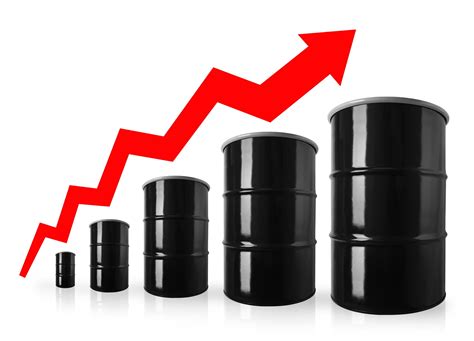Introduction:
The global energy landscape is undergoing a transformative shift, marked by heightened volatility and skyrocketing prices for crude oil. Analysts project a surge in the average price of a barrel of crude oil to an unprecedented $110 by 2025. This article delves into the factors driving this upward trajectory, its potential implications, and the strategies stakeholders can adopt to navigate this challenging market environment.

Drivers of the Price Surge:
1. Post-Pandemic Economic Recovery:
The global economy is rebounding from the pandemic-induced downturn, fueling an upswing in demand for energy, particularly crude oil. As economies recover, industrial production, transportation, and travel activities increase, leading to a surge in oil consumption.
2. Supply Chain Disruptions:
The COVID-19 pandemic exacerbated supply chain disruptions, impacting the production and distribution of crude oil. Lockdowns and travel restrictions hindered labor availability and disrupted logistics, leading to reduced supply and higher prices. Additionally, geopolitical tensions and conflicts can further disrupt supply chains, exacerbating the price surge.
3. Underinvestment in Exploration and Production:
The energy transition towards renewable sources has led to a decline in investments in oil exploration and production. This underinvestment has constrained supply, particularly in countries with high production costs. The lack of new discoveries and dwindling existing reserves are contributing to the rising prices.
4. Geopolitical Instability:
Political instability in major oil-producing regions, such as the Middle East and Venezuela, can disrupt production and exacerbate price volatility. These regions have historically accounted for a significant share of global crude oil supplies, and any disruption can create market uncertainty and drive up prices.
5. International Agreements:
International agreements, such as the Paris Agreement on climate change, are encouraging the transition to cleaner energy sources. However, the transition is not uniform across all countries, and the continued demand for fossil fuels, particularly in developing economies, is pushing up prices.
Implications of High Crude Prices:
1. Increased Energy Costs:
Higher crude prices translate into increased energy costs for businesses and consumers worldwide. This can have ripple effects on production costs, inflation, and overall economic growth.
2. Inflationary Pressures:
The rising cost of energy spills over into other sectors of the economy, contributing to inflationary pressures. This can erode purchasing power and reduce consumer spending.
3. Economic Slowdown:
Sustained high crude prices can stifle economic growth by reducing disposable income and dampening business investment. Businesses may be forced to reconsider expansion plans or cut back on operations.
4. Political and Social Unrest:
Extreme oil prices can lead to political and social unrest in countries heavily reliant on imported oil. This can create instability and disrupt economic activity.
Stakeholder Strategies:
1. Governments:
- Encourage investments in renewable energy sources to reduce dependence on fossil fuels.
- Implement policies to promote energy efficiency and conservation.
- Consider strategic reserves and price stabilization mechanisms to mitigate price shocks.
2. Businesses:
- Explore alternative energy sources and reduce fossil fuel consumption wherever possible.
- Optimize operations for energy efficiency and reduce operating costs.
- Consider hedging and other financial instruments to manage price risks.
3. Consumers:
- Adopt energy-efficient practices in daily life to reduce consumption.
- Consider fuel-efficient vehicles and public transportation to minimize transportation costs.
Market Insights:
1. Rising Demand in Emerging Markets:
Developing countries are projected to experience significant economic growth, leading to increased demand for energy, particularly oil. This demand will continue to support high prices in the coming years.
2. Transition to Cleaner Fuels:
While the transition to renewable energy sources is gaining momentum, oil will remain a significant energy source for the foreseeable future. The ongoing demand for oil, coupled with supply constraints, will sustain high prices until cleaner alternatives become widely available.
3. Evolving Energy Landscape:
The energy landscape is evolving rapidly, with advancements in technology and the emergence of new energy sources. Companies are exploring innovation in oil extraction methods, while others are investing heavily in renewable energy. This dynamic environment creates opportunities for growth and disruption.
Tables:
Table 1: Projected Average Price for Barrel of Crude Oil
| Year | Price |
|---|---|
| 2023 | $85 |
| 2024 | $95 |
| 2025 | $110 |
Table 2: Factors Driving Crude Oil Price Surge
| Factor | Impact |
|---|---|
| Post-pandemic economic recovery | Increased demand |
| Supply chain disruptions | Reduced supply |
| Underinvestment in exploration and production | Constrained supply |
| Geopolitical instability | Market uncertainty and supply risks |
| International agreements | Reduced supply from transitioning countries |
Table 3: Implications of High Crude Prices
| Impact | Consequence |
|---|---|
| Increased energy costs | Higher production costs and reduced consumer spending |
| Inflationary pressures | Eroded purchasing power and reduced economic growth |
| Economic slowdown | Reduced business investment and dampened economic activity |
| Political and social unrest | Instability in oil-dependent countries |
Table 4: Stakeholder Strategies to Address High Crude Prices
| Stakeholder | Strategy |
|---|---|
| Governments | Investments in renewable energy, energy efficiency policies, strategic reserves |
| Businesses | Alternative energy exploration, energy efficiency optimization, hedging |
| Consumers | Energy-efficient practices, fuel-efficient vehicles, reduced consumption |


